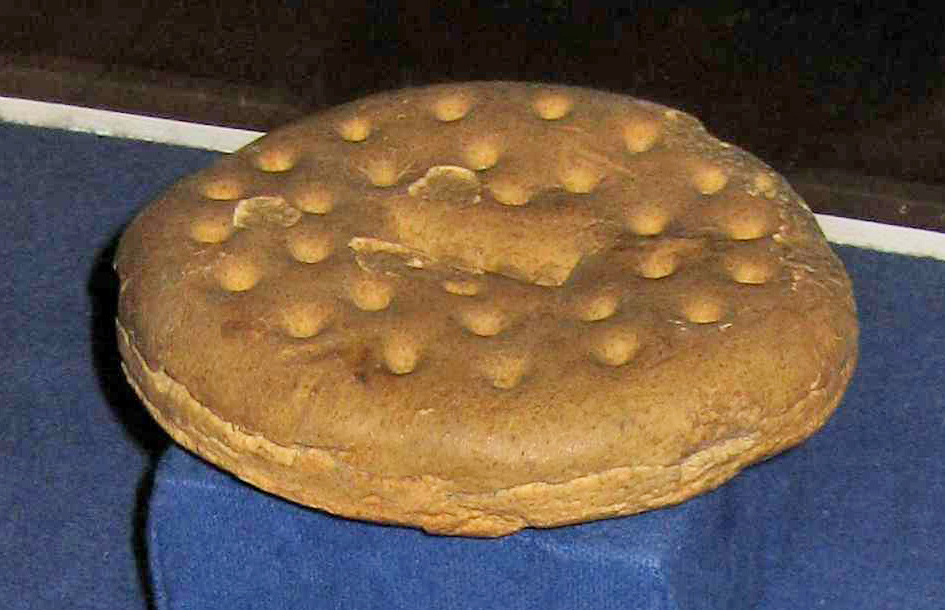
I learned this today. Hardtack is a dense biscuit made from flour, water, and sometimes salt. It was sometimes called “ship’s biscuit” because it was a staple on long voyages.
The word “hardtack” comes from the British sailor slang for food, “tack”. It was called “hardtack” because it was extremely hard.
Hardtack is a very basic form of bread and, as such, there is no way of knowing when it was invented. Early humans started to bake bread about 14,000 years ago. Many different cultures have carried hardened bread with them when they travel. Egyptian sailors carried a flat loaf of bread called dhourra. Roman soldiers carried a biscuit called bucellatum.
Bucellatum was a basic biscuit made from flour, water, and salt. It was baked twice to remove all of the moisture. It was very hard and would last a very long time. Because it had no moisture in it, it would not go rotten. Regular bread can go bad very quickly in damp climates, but bucellatum would last for months. In fact, the Roman soldiers relied on it to such an extent that some groups of Roman soldiers were called bucellarii, (biscuit-eater).
Soldiers have carried a type of hardtack throughout history. They have also been used on boats and that is probably where they are most famous.
In the 15th century, the Age of Discovery in Europe started. It lasted until the end of the 17th century and European explorers sailed over the whole globe. There are several causes for this sudden desire to explore the seas. Here are a few of them.
The Mongol Empire collapsed, and the overland Silk Road was not as safe as it used to be.
Europeans wanted to find other places to trade with and other routes to the Far East.
The populations of European countries were rapidly rebounding after the Great Plagues and the market for trade was increasing.
Absolute monarchies in European countries had finally formed and consolidated all of their authority and wealth.
There had been dramatic improvements in ship building and navigation. The Portuguese had built a ship that was lighter and could travel farther. They started to explore the coast of Africa in the early 1400s.
The Age of Discovery introduced ships that could sail farther and stay at sea for longer. If sailors are going to be at sea for several months at a time, they have to be fed. Ships would carry many different types of food but, almost without exception, they would have hardtack.
In 1568, a Spanish ship carried hardtack, wine, water, beans, chickpeas, salted fish, rice, oil, salted pork, salted beef, cheese, and vinegar. The daily ration consisted of hardtack plus salted meat or fish and something else. Ships that were at sea for a long time couldn’t carry fresh meat, fruit, or vegetables because they would rot. The only things they could carry were heavily salted meats or dried foods.
Each sailor would be given a daily ration of about a pound of hardtack plus salted meats. The reason that the hardtack was so easy to carry on ships was because it was extremely hard and dry. Hardtack carried on British ships was baked four times to make it as dry and hard as possible. The very quality that made it good to store made it almost impossible to eat. Sailors had to soak it in whatever drink they had to soften it enough to eat. One of its nicknames was molar breaker. Some sailors would break a piece off and suck it to soften it. They could be sucking the same piece for a long time.
Hardtack wasn’t appetizing to eat, but it did pack a lot of calories into its small size. It was possible to survive on nothing but hardtack for months at a time, but it wasn’t healthy to do so. Scurvy was a huge problem on ships at the time. It is caused by a vitamin C deficiency and can ultimately be fatal if not treated. Vitamin C is needed for the production of collagen and our bodies can’t cope without that. One thing that hardtack and salted meats don’t have is vitamin C. There was not a single ocean-going ship that didn’t have a case of scurvy until 1780 when Gilbert Blane forced the British Navy to give citrus juice to sailors on ships. He had it added to the sailors’ drinks and the vitamin C fixed the scurvy. They started using lemons, but limes were easier to get from their Caribbean colonies. Interestingly, this is why British people are known as limeys.
Because hardtack was very calorific, it was plagued by rats and insects on the voyages. All ships would have a colony of rats on them and the rats would gnaw at the hardtack. What they didn’t eat, they would urinate or defecate on. Insects would also bore into the hardtack. Weevil larvae were the biggest problem. This gave rise to another nickname for hardtack: wormcastle. Sailors and soldiers would drop the biscuit into their coffee and then scrape off the insects and maggots when they floated to the top.
So, hardtack is a flour, water, and salt biscuit that was carried on most ships during the Age of Exploration and even up until the late 19th century. It wasn’t until the invention of canning that hardtack died out. And this is what I learned today.
By Paul A. Cziko, CC BY 2.5, https://commons.wikimedia.org/w/index.php?curid=22172272
Sources:
https://www.atlasobscura.com/articles/ship-food-research-recreation-beer
http://www.pbchistoryonline.org/page/what-did-sailors-eat
http://www.thepeacefulsea.com/life-at-sea.html
https://fromhungertohope.com/what-did-sailors-eat-in-the-1500s
https://maefood.blogspot.com/2012/06/what-did-magellan-and-his-sailors-eat.html
https://en.wikipedia.org/wiki/Hardtack
https://www.montana.edu/historybug/civilwar2/infested.html
http://pass-the-garum.blogspot.com/2014/10/bucellatum-roman-army-hardtack.html
https://en.wikipedia.org/wiki/Bucellarii
https://www.thc.texas.gov/blog/hardtack-original-mre
https://www.historycrunch.com/causes-of-the-age-of-exploration.html#/
https://en.wikipedia.org/wiki/Age_of_Discovery
https://www.nationalgeographic.com/science/article/scurvy-disease-discovery-jonathan-lamb

Pingback: #344 What are vitamins? - I Learned This Today